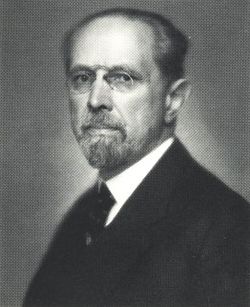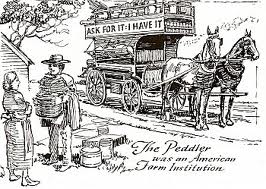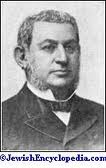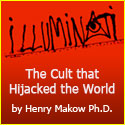Werner Sombart - "Americanism is the Jewish Spirit Distilled"
August 14, 2024

(left, The distinguished German sociologist Werner Sombart, 1863-1941)
In his book "The Jews & Modern Capitalism," (1911) German sociologist
In the excerpt below, he says Jews built the USA to become the epitome of capitalism:
"Nineteen [families] were equipped with plow and scythe, ready to clear the forests and till the soil in order to earn their livelihood as husbandmen...The twentieth family opened a store...Accordingly, it may be said that American economic life was from its very start impregnated with capitalism. And who was responsible for this? The twentieth family in each village. Need we add that this twentieth family was always a Jewish one, which joined a party of settlers or soon sought them out in their homesteads?"
(from The Jews & Modern Capitalism, 1911, pp.35-39)
May 1, 2012
(henrymakow.com)
For what we call Americanism is nothing else, if we may say so than the Jewish spirit distilled. But how comes it that American culture is so steeped in Jewishness?
The answer is simple -- through the early and universal admixture of Jewish elements among the first settlers.
We may picture the process of colonizing somewhat after this fashion. A band of determined men and women -- let us say twenty families -- went forth into the wilds to begin their life anew. Nineteen were equipped with ploughs and scythes, ready to clear the forests and till the soil in order to earn their livelihood as husbandmen.
The twentieth family opened a store to provide their companions with such necessaries of life as could not be obtained from the soil, often no doubt hawking them at the very doors.
Soon this twentieth family made it its business to arrange for the distribution of the products which the other nineteen won from the soil. It was they, too, who were most likely in possession of ready cash, and in case of need could therefore be useful to the others by lending them money.
Very often the store had a kind of agricultural loan bank as its adjunct, perhaps also an office for the buying and selling of land. So through the activity of the twentieth family, the farmer in North America was from the first kept in touch with the money and credit system of the Old World.
Hence the whole process of production and exchange was from its inception along modern lines. Town methods made their way at once into even the most distant villages.
Accordingly, it may be said that American economic life was from its very start impregnated with capitalism. And who was responsible for this? The twentieth family in each village. Need we add that this twentieth family was always a Jewish one, which joined a party of settlers or soon sought them out in their homesteads?
EXAMPLES
Such an outline is the mental picture I have conceived of the economic development of the United States. Subsequent writers dealing with this subject will be able to fill in more ample details; I myself have only come across a few. But these are so similar in character that they can hardly be taken as isolated instances. The conclusion is forced upon us that they are typical.
Nor do I alone hold this view. Governor Pardel of California, for example, remarked in 1905: "He (the Jew) has been the leading financier of thousands of prosperous communities. He has been enterprising and aggressive."
Let me quote some of the illustrations I have met with. In 1785 Abraham Mordecai settled in Alabama. "He established a trading post two miles west of Line Creek, carrying on an extensive trade with the Indians, and exchanging his goods for pink-root, hickory, nut oil, and peltries of all kinds."
Similarly in Albany: "As early as 1661, when Albany was but a small trading post, a Jewish trader named Asser Levi (or Leevi) became the owner of real estate there."
Chicago has the same story. The first brick house was built by a Jew, Benedict Schubert, who became the first merchant tailor in Chicago, while another Jew, Philip Newburg, was the first to introduce the tobacco business.
 In Kentucky, we hear of a Jewish settler as early as 1816. When in that year the Bank of the United States opened a branch in Lexington, Mr. Solomon, who had arrived in 1808, was made cashier. In Maryland, Michigan, Ohio, and Pennsylvania it is on record that Jewish traders were among the earliest settlers, though nothing is known of their activity.
In Kentucky, we hear of a Jewish settler as early as 1816. When in that year the Bank of the United States opened a branch in Lexington, Mr. Solomon, who had arrived in 1808, was made cashier. In Maryland, Michigan, Ohio, and Pennsylvania it is on record that Jewish traders were among the earliest settlers, though nothing is known of their activity.On the other hand, a great deal is known of Jews in Texas, where they were among the pioneers of capitalism. Thus, for example, Jacob de Cordova "was by far the most extensive land locator in the State until 1856."
The Cordova's Land Agency soon became famous not only in Texas but in New York, Philadelphia, and Baltimore, where the owners of large tracts of Texas land resided. Again, Morris Koppore in 1863 became President of the National Bank of Texas.
Henry Castro was an immigration agent; "between the years 1843-6 Castro introduced into Texas over 5000 immigrants . . . transporting them in 27 ships, chiefly from the Rhenish provinces. . . . He fed his colonists for a year, furnished them with cows, farming implements, seeds, medicine, and in short with everything they needed."
Sometimes branches of one and the same family distributed themselves in different States and were thereby enabled to carry on business most successfully. Perhaps the best instance is the history of the Seligman family. There were eight brothers (the sons of David Seligman, of Bayersdorf, in Bavaria) who started a concern which now has branches in all the most important centers in the States.
Their story began with the arrival in America in the year 1837 of Joseph Seligman. Two other brothers followed in 1839; a third came two years later. The four began business as clothiers in Lancaster, moving shortly after to Selma, Ala.
From here they opened three branches in three other towns. By 1848, two more brothers had arrived from Germany and the six moved North.
 In 1850, Jesse Seligman opened a shop in San Francisco -- in the first brick house in that city.
In 1850, Jesse Seligman opened a shop in San Francisco -- in the first brick house in that city. Seven years later a banking business was added to the clothing shop, and in 1862 the house of the Seligman Brothers was established in New York, San Francisco, London, Paris, and Frankfort.
In the Southern States likewise, the Jew played the part of the trader in the midst of agricultural settlers.
Here also (as in Southern and Central America) we find him quite early as the owner of vast plantations. In South Carolina indeed, "Jew's Land" is synonymous with "Large Plantations."
It was in the South that Moses Lindo became famous as one of the first undertakers in the production of indigo.
These examples must suffice. We believe they tend to illustrate our general statement, which is supported also by the fact that there was a constant stream of Jewish emigration to the United States from their
earliest foundation. It is true that there are no actual figures to show the proportion of the Jewish population to the total body of settlers. But the numerous indications of a general nature that we do find make it pretty
certain that there must always have been a large number of Jews in America.
It must not be forgotten that in the earliest years, the population was thinly scattered and very sparse. New Amsterdam had less than 1000 inhabitants.
That being so, a ship full of Jews who came from Brazil to settle there made a great difference, and in assessing Jewish influence on the whole district we shall have to rate it highly.
Or take another instance. When the first settlement in Georgia was established, forty Jews were among the settlers. The number may seem insignificant, but when we consider the meager population of the colony, Jewish influence must be accounted strong. So, too, in Savannah, where in 1733 there were already twelve Jewish families in what was then a tiny commercial centre.
That America early became the goal of German and Polish Jewish emigrants is well known. Thus we are told: "Among the poorer Jewish families of Posen there was seldom one which in the second quarter of
the 19th century did not have at least one son (and in most cases the ablest and not least enterprising) who sailed away across the ocean to flee from the narrowness and the oppression of his native land."
We are not surprised, therefore, at the comparatively large number of Jewish soldiers (7243 ) who took part in the Civil War, and we should be inclined to say that the estimate which puts the Jewish population of the
United States about the middle of the 19th century at 300,000 (of whom 30,000 lived in New York) was if anything too moderate.
Related - Sombart--Jews and their Temperament
Roger Lowenstein: America's Bank
https://rogerlowenstein.com/
The Jewish Story Behind the U.S. Federal Reserve Bank - The Forward
https://forward.com/culture/
Jewish Banking Families Top the Pyramid of Power: Highlights Part 1
https://karlhaemers.substack.
ReplyReply allForward |







rh said (August 14, 2024):
Perhaps, a reading of the fable, “The Goose that Laid the Golden Eggs.”is in order.
Seems to me, some people have done well in America. Then again, some people struggle figuring out when enough is enough? I can not see a democracy working when 80% of the wealth is owned by 10% of the people. We may not be there yet, but its heading in that direction. Poor people make for a poor Democracy.